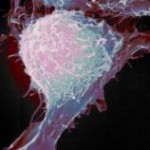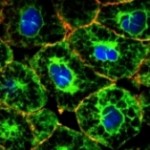 전립선암은 전립선 암줄기세포(prostate cancer stem cells)라고 부르는 드문 소집단 세포(subpopulation of cells)에서 유래합니다. 종양세포 중 극히 소수(1% 미만)를 차지하는 암줄기세포는 여러 암의 발달과 재발에 중요한 역할을 합니다. 이들 세포는 증식능력에 한계가 없는 각 세포의 분열로 자가복제(self-renewal)를 하는 줄기세포의 특징을 충분히 지녔습니다. 더욱이 암줄기세포는 죽지 않으며, 오히려 치료에 저항하고 전형적인 줄기세포 표식인자(표면항원)을 발현합니다. 잔존하는 이들 암줄기세포의 발생 기원은 아직 분명히 밝혀지지 않았습니다.
전립선암은 전립선 암줄기세포(prostate cancer stem cells)라고 부르는 드문 소집단 세포(subpopulation of cells)에서 유래합니다. 종양세포 중 극히 소수(1% 미만)를 차지하는 암줄기세포는 여러 암의 발달과 재발에 중요한 역할을 합니다. 이들 세포는 증식능력에 한계가 없는 각 세포의 분열로 자가복제(self-renewal)를 하는 줄기세포의 특징을 충분히 지녔습니다. 더욱이 암줄기세포는 죽지 않으며, 오히려 치료에 저항하고 전형적인 줄기세포 표식인자(표면항원)을 발현합니다. 잔존하는 이들 암줄기세포의 발생 기원은 아직 분명히 밝혀지지 않았습니다.
전통적인 전립선암 치료법은 주로 대부분의 분화된 종양세포(differentiated tumor cells)를 표적으로 삼지만, 그러나 암줄기세포는 손상을 받지 않고 건재합니다. 이것이 항암제내성을 지닌 새로운 암세포가 생기고 재발하는 이유입니다. 만일 환자에게서 관해(remission) 후 5년내에 암이 다시 나타나면 재발한 것으로 보아야 합니다. 따라서 암줄기세포를 성공적으로 제거하는 것은 암의 완치를 위한 효과적인 전략입니다. 암줄기세포를 죽이는 것은 가장 우선순위임이 분명합니다.
전립선암 줄기세포는 분화된 종양세포를 성장시키며, 또한 자가복제(self-renewal)를 하는 종양 내 CD44+ 소집단입니다. 다음 연구보고는 전립선암 특이 줄기세포가 전구염증성(pro-inflammatory)이라는 것을 보여줍니다. 활성화되는 주된 신호전달경로는 Wnt/β-catenin, 노치(Notch), 헤지혹(Hedgehog), EGF-like/EGFR/Neu, LIF, TGF-β, 인테그린(integrins), 텔로머라제(telomerase), SDF-1/CXCR4, 프로락틴/성장호르몬(prolactin/growth hormone), IGF-1 시스템, ER/PR이 확인되었습니다.
Stem cells: The root of prostate cancer?
Prostate cancer stem cells: a new target for therapy.
Revisiting the concept of cancer stem cells in prostate cancer.
Prostate cancer stem cell biology.
Prostate cancer stem cells and their potential roles in metastasis.
Cancer stem cell markers in common cancers – therapeutic implications.
 WNT 신호경로는 수 많은 조직내 줄기세포의 분화와 전분화능(pluripotency: 모든 종류의 세포로. 분화할수 있는 능력)을 제어하는 핵심적인 역할을 합니다. 전립선암에서 WNT리간드는 상향조절(up-regulated)되며, 이들의 발현은 전립선암의 공격적인성향 및 전이성(metastasis)과 흔히 상관관계가 있습니다. 전이성 전립선암은 현재 치료법이 없습니다.
WNT 신호경로는 수 많은 조직내 줄기세포의 분화와 전분화능(pluripotency: 모든 종류의 세포로. 분화할수 있는 능력)을 제어하는 핵심적인 역할을 합니다. 전립선암에서 WNT리간드는 상향조절(up-regulated)되며, 이들의 발현은 전립선암의 공격적인성향 및 전이성(metastasis)과 흔히 상관관계가 있습니다. 전이성 전립선암은 현재 치료법이 없습니다.
WNT리간드는 세포로부터 분비되는 당단백질 계열입니다. WNT는 19가지의 다른 종류가 있으며, 이들은 세포막 외부에 존재합니다. WNT가 활성화되면 WNT에 의해 베타카테닌(β-catenin)이란 단백질이 활성화되고 세포핵(nucleus)으로 들어갑니다. 일단 세포핵으로 들어가면, 베타카테닌(β-catenin)은 특정한 전사적 표적을 조절하기 위해 다양한 핵인자들(nuclear factors)과 상호작용을 합니다. WNT/β-catenin 경로의 과발현은 대장암, 전립선암, 흑색종을 포함한 모든 종류의 암에서 흔히 나타납니다.
WNT/β-catenin 신호경로는 암줄기세포의 증식에 중요합니다. 그러므로, WNT/β-catenin 신호경로의 억제는 전립선암의 유망한 치료책입니다. 아울러 WNT/β-catenin 신호경로는 전립선암의 진행으로 발전하는 전립선증식의 핵심적 조절자 안드로겐수용체(androgen receptor, AR)와도 깊이 연관되어 있습니다.
Roles and regulation of Wnt signaling and beta-catenin in prostate cancer.
Wnt/β-catenin signalling in prostate cancer.
Activation of β-catenin signaling in androgen receptor-negative prostate cancer cells.
과학자들은 감마 토코트리에놀(gamma-tocotrienol)이 전립선암 줄기세포를 죽이는 잠재적 효능을 지녔다는 것을 밝혔습니다. 감마 토코트리에놀은 비타민 E의 일종으로, 그동안 여러 종류의 암에 광범위한 항암작용을 하는 것으로 밝혀졌습니다. 비타민 E에는 2가지 클래스(토코페롤, 토코트리에놀)이 있으며, 각각의 클래스에는 4가지(알파, 베타, 감마, 델타)의 다른 구조의 비타민 E가 있습니다 (총 8가지 비타민E가 존재).
이 연구는 전립선암 줄기세포의 근절방법을 찾는 것이 목적이었습니다. 과증식된 전립선암 종괴(종양 덩어리)를 표적으로 한 선행된 연구보고에서는 감마 토코트리에놀이 효과적인 것으로 밝혀졌습니다. 연구에서 저용량의 감마 토코트리에놀이 전립선암 줄기세포에 세포자멸사(apoptosis)를 유도하고, 이들의 군체형성능력(colony formation capability)을 억제하는 요인으로 작용한다는 것이 밝혀졌습니다. 결과적으로 전립선암 줄기세포군이 감소하였습니다 (CD44와 CD 133 단백질로 확인).
호르몬-불응성 전립선암 세포를 이식한 쥐 모델을 대상으로 한 추가 실험에서는 감마 토코트리에놀을 물에 타 먹였습니다. 실험결과 감마 토코트리에놀이 이미 형성된 전립선암 종양의 크기를 줄여줄 뿐만 아니라, 또한 종양발생율을 75% 줄여주는 것으로 밝혀졌습니다 (비교그룹은 100% 종양발생). 이 결과들은 감마 토코트리에놀이 전립선암의 예방과 치료용으로 개발될 수 있음을 제시합니다. 이러한 확인으로 전립선암의 예방과 치료를 위한 자연요법에서도 감마 토코트리에놀의 커다란 가능성이 대두되었습니다. 우리는 감마 토코트리에놀의 전립선암 줄기세포 살상능력이 Wnt/β-catenin 신호경로를 조절하는 감마 토코트리에놀의 능력을 통해 나타나는 것으로 믿고 있습니다..
Gamma-tocotrienol as an effective agent in targeting prostate cancer stem cell-like population.
Tocotrienol as a potential anticancer agent.
아울러, 감마 토코트리에놀은 복합적인 여러 작용기전을 통해 전립선암 세포의 증식과 침윤을 억제합니다.
Gamma-tocotrienol metabolism and antiproliferative effect in prostate cancer cells.
γ-Tocotrienol induces growth arrest through a novel pathway with TGFβ2 in prostate cancer.
감마 토코트리에놀은 천연적으로 팜오일(palm oil)에서 추출됩니다. 특히 정제(열처리)하지 않은 오르가닉 레드팜오일(red palm oil)은 항암 감마 토코트리에놀이 가장 풍부한 공급원입니다. 레드팜짐(Red-PalmZym)은 오르가닉 버진 레드팜오일을 천연적으로 발효숙성처리한 것입니다. 레드팜짐(Red-PalmZym)에는 가장 순도가 높고 생리적이용율이 높은 항암 감마 토코트리에놀이 함유되어 있습니다.
레드팜짐(Red-PalmZym)은 복합 비타민 E와 복합 카로티노이드(carotenoids), 비타민 K. CoQ10, 스쿠알렌(squalene), 파이토스테롤(phytosterols) 및 다른 영양소들을 제공하는 천연 공급원의 보충제로 사용할 수 있습니다.
Natural Red Palm Oil (high in saturated fat) kills Cancer Cells
The fermented red palm oil miracle
탁월한 항암작용의 레드팜오일(red palm oil)과 레드팜짐(천연숙성 레드팜오일)의 놀라운 효능 (1)
탁월한 항암작용의 레드팜오일(red palm oil)과 레드팜짐(천연숙성 레드팜오일)의 놀라운 효능 (2)
탁월한 항암작용의 레드팜오일(red palm oil)과 레드팜짐(천연숙성 레드팜오일)의 놀라운 효능 (3)
실리비닌(silibinin)과 커큐민(curcumin) 역시 Wnt/β-catenin신호경로를 억제합니다.